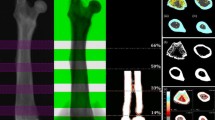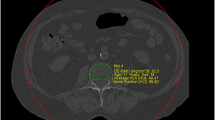Abstract
Up to now it has not been possible to reliably cross-calibrate dual-energy X-ray absorptiometry (DXA) densitometry equipment made by different manufacturers so that a measurement made on an individual subject can be expressed in the units used with a different type of machine. Manufacturers have adopted various procedures for edge detection and calibration, producing various normal ranges which are specific to each individual manufacturer's brand of machine. In this study we have used the recently described European Spine Phantom (ESP, prototype version), which contains three semi-anthropomorphic “vertebrae” of different densities made of simulated cortical and trabecular bone, to calibrate a range of DXA densitometers and quantitative computed tomography (QCT) equipment used in the measurement of trabecular bone density of the lumbar vertebrae. Three brands of QCT equipment and three brands of DXA equipment were assessed. Repeat measurements were made to assess machine stability. With the large majority of machines which proved stable, mean values were obtained for the measured low, medium and high density vertebrae respectively. In the case of the QCT equipment these means were for the trabecular bone density, and in the case of the DXA equipment for vertebral body bone density in the posteroanterior projection. All DXA machines overestimated the projected area of the vertebral bodies by incorporating variable amounts of transverse process. In general, the QCT equipment gave measured values which were close to the specified values for trabecular density, but there were substantial differences from the specified values in the results provided by the three DXA brands. For the QCT and Norland DXA machines (posteroanterior view), the relationships between specified densities and observed densities were found to be linear, whereas for the other DXA equipment (posteroanterior view), slightly curvilinear, exponential fits were found to be necessary to fit the plots of observed versus specified densities. From these plots, individual calibration equations were derived for each machine studied. For optimal cross-calibration, it was found to be necessary to use an individual calibration equation for each machine. This study has shown that it is possible to cross-calibrate DXA as well as QCT equipment for the measurement of axial bone density. This will be of considerable benefit for large-scale epidemiological studies as well as for multi-site clinical studies depending on bone densitometry.
Similar content being viewed by others
References
Kelly TL, Slovik DM, Neer RM. Calibration and standardization of bone mineral densitometers. J Bone Miner Res 1989;4:663–9.
Hochberg AM, Wahner HW, Dunn WL, Bevan J, Stein J. A performance comparison of x-ray and gamma-ray bone mineral analyzers utilizing a standard spine phantom. In: Dequeker J, Geusens P, Wahner HW, editors. Bone mineral measurements by photon absorptiometry: methodological problems. Leuven, Belgium: Leuven University Press, 1988: 242–5.
Kelly TL, Slovik DM, Schoenfeld DA, Neer RM. Quantitative digital radiography versus dual photon absorptiometry of the lumbar spine. J Clin Endocrinol Metab 1988;67:839–44.
Borders J, Kerr E, Sartoris DJ, Stein JA, Ramos E, Moscona AA, Resnick D. Quantitative dual-energy radiographic absorptiometry of the lumbar spine: in vivo comparison with dual-photon absorptiometry. Radiology 1989;170:129–31.
Wahner HW, Dunn WL, Brown ML, Morin RL, Riggs BL. Comparison of dual-energy x-ray absorptiometry and dual photon absorptiometry for bone mineral measurements of the lumbar spine. Mayo Clin Proc 1988;63:1075–84.
Orwoll ES, Oviatt SK, Biddle JA. Precision of dual-energy x-ray absorptiometry: development of quality control rules and their application in longitudinal studies. J Bone Miner Res 1993;8:693–9.
Glüer CC, Faulkner KG, Estilo MJ, et al. Quality assurance for bone densitometry research studies: concept and impact. Osteoporosis Int 1993;3:227–35.
Svendsen OL, Marslew U, Hassager C, Christiansen C. Measurement of bone mineral density of the proximal femur by two commercially available dual energy X-ray absorptiometric systems. Eur J Nucl Med 1992;19:41–6.
Pocock NA, Sambrook PN, Nguyen T, Kelly P, Freund J, Eisman JA. Assessment of spinal and femoral bone density by dual X-ray absorptiometry: comparisons, of Lunar and Hologic instruments. J Bone Miner Res 1992;7:1081–4.
Lai KC, Goodsitt MM, Murano R, Chesnut CH. A comparison of two dual-energy X-ray absorptiometry systems for spinal bone mineral measurement. Calcif Tissue Int 1992;50:203–8.
Laskey MA, Flaxman ME, Barber RW, Trafford S, Hayball MP, Lyttle KD, Crisp AJ, Compston JE. Comparative performance in vitro and in vivo of Lunar DPX and Hologic QDR-1000 dual energy x-ray absorptiometers. Br J Radiol 1991;64:1023–9.
Laskey MA, Crisp AJ, Cole TJ, Compston JE. Comparison of the effect of different reference data on Lunar DPX and Hologic QDR-1000 dual energy X-ray absorptiometers. Br J Radiol 1992;65:1124–9.
Morita R, Orimo H, Hamamoto I, Fukunaga M, Shiraki M, Nakamura T, et al. Some problems of dual energy X-ray absorptiometry in clinical use. Osteoporosis Int 1993;3(Suppl):S87–90.
Genant HK, Grampp S, Glüer CC, Faulkner KG, Jergas M, Engelke K, et al. Universal standardization for dual X-ray absorptiometry: patient and phantom cross-calibration results. J Bone Miner Res 1994;9:1503–14.
Goodsitt MM, Johnson RH, Chesnut CH. A new set of calibration standards for estimating the fat and mineral content of vertebrae via dual energy QCT. Bone Miner 1991;13:217–33.
Steenbeek JCM, van Kuijk C, Grashuis JL. Influence of calibration materials in single and dual-energy quantitative CT. Radiology 1992;83:849–55.
Faulkner KG, Glüer CC, Grampp S, Genant HK. Cross-calibration of liquid and solid QCT calibration standards: corrections to the UCSF normative data. Osteoporosis Int 1993;3:36–42.
Healey J, Williams-Russo P, Szatrowski T, Schneider R, Paget S, Ales K, Schwarzberg P. Comparison of quantative CT denitometry using liquid versus solid phantoms. J Bone Miner Res 1992;7(Suppl 1):S179.
Suzuki S, Yamamuro T, Okumura H, Yamamoto I. Quantitative computed tomography: comparative study using different scanners with two calibration phantoms. Br J Radiol 1991; 64:1001–6.
Whitehouse RW, Adams JE. Single energy quantative computed tomography: the effects of phantom calibration material and kVp on QCT bone densitometry. Br J Radiol 1992;65:931–4.
Kalender WA. A phantom for standardization and quality control in spinal bone mineral measurements by QCT and DXA: design considerations and specifications. Med Phys 1992;19:583–6.
Jonson R. Mass attenuation coefficients, quantities and units for use in bone mineral determinations. Osteoporosis Int 1993;3:103–6.
Genant HK, Faulkner KG, Glüer CC. Measurement of bone mineral density: current status. Am J Med 1991;91(Suppl 5B):49S-53S.
Sandor T, Felsenberg D, Kalender WA, Clain A, Brown E. Compact and trabecular components of the spine using quantitative computed tomography. Calcif Tissue Int 1992;50:502–6.
Steiger P, Block JE, Steiger S, Heuck AF, Friedlander A, Ettinger B, et al. Spinal bone mineral density measured with quantitative CT: effect of region of interest, vertebral level and technique. Radiology 1990;175:537–43.
Kalender WA, Fischer M. Quality control and standardisation of absorptiometric and computed tomographic measurements of bone mineral mass and density. Radiat Protection Dosimetry 1993;49:229–33.
Mazess RB, Trempe JA, Bisek JP, Hanson JA, Hans D. Calibration of dual-energy X-ray absorptiometry for bone density. J Bone Miner Res 1991;6:799–806.
Faulkner KG, Glüer C-C, Estilo M, Genant HK. Cross-calibration of DXA equipment: upgrading from a Hologic QDR 1000W to a QDR 2000. Calcif Tissue Int 1993;52:79–84.
Trevisan C, Gandolini GG, Sibilla P, Penotte M, Caraceni MP, Ortolani S. Bone mass measurements by DXA: influence of analysis procedures and interunit variation. J Bone Miner Res 1992;7:1373–82.
Pearson J, Dequeker J, Reeve J, Felsenberg D, Henley M, Bright J, et al. Dual X-ray absorptiometry of the proximal femur: normal European values standardised with the European Spine Phantom. J Bone Miner Res (in press).
Author information
Authors and Affiliations
Additional information
A Concerted Action of the European Community's COMAC-BME programme 1989–92. For further details of the Study Group see Appendix.
Rights and permissions
About this article
Cite this article
Pearson, J., Dequeker, J., Henley, M. et al. European semi-anthropomorphic spine phantom for the calibration of bone densitometers: Assessment of precision, stability and accuracy the European quantitation of osteoporosis study group. Osteoporosis Int 5, 174–184 (1995). https://doi.org/10.1007/BF02106097
Received:
Issue Date:
DOI: https://doi.org/10.1007/BF02106097




